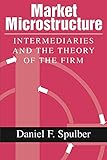Market microstructure : Intermediaries and the theory of the firm
Publication details: Cambridge Cambridge University Press 1999Description: 374p xxixISBN:- 0521659787
- 338.5 SPU SPU
| Item type | Current library | Shelving location | Call number | Status | Date due | Barcode |
|---|---|---|---|---|---|---|
 BOOKs
BOOKs
|
National Law School | Library Compactors | 338.5 SPU (Browse shelf(Opens below)) | Available | 15413 |
Contents;
Preface and acknowledgments;
Introduction;
Part I: Market microstructure and the intermediation theory of the firm;
1 Market microstructure and intermediation;
1.1 Who decides?
1.2 The circular flow of economic activity;
1.3 Comparison with other economic theories of the firm;
1.4 Intermediation in the U.S. economy;
1.5 Conclusion;
2 Price setting and intermediation by firms;
2.1 Price setting by intermediaries;
2.2 Allocation under uncertainty and over time;
2.3 Price adjustment by intermediaries;
2.4 Inventories and market clearing by intermediaries;
2.5 Conclusion;
Part II: Competition and market equilibrium;
3 Competition between intermediaries;
3.1 Bertrand competition for inputs with homogeneous products;
3.2 Bertrand price competition with differentiated products and purchases;
3.3 Bertrand competition with switching costs;
3.4 Bertrand competition when costs differ;
3.5 Conclusion;
4 Intermediation and general equilibrium;
4.1 The neoclassical theory of the firm;
4.2 Transaction costs and Walrasian equilibrium;
4.3 Monopoly intermediation in general equilibrium;
4.4 Monopolistic competition;
4.5 Conclusion;
Appendix;
Part III: Intermediation versus decentralized trade;
5 Matching and intermediation by firms;
5.1 Intermediation versus a matching market;
5.2 Costly intermediation;
5.3 Intermediation with random matching;
5.4 Intermediation and matching with production;
5.5 Conclusion;
6 Search and intermediation by firms;
6.1 The market model;
6.2 Market equilibrium;
6.3 Comparison with Walrasian equilibrium and with monopoly;
6.4 Market equilibrium with continual entry of consumers and suppliers;
6.5 Conclusion;
Appendix;
Part IV: Intermediation under asymmetric information;
7 Adverse selection in product markets;
7.1 Intermediated trade;
7.2 Intermediated trade with production;
7.3 Market clearing by intermediaries;
7.4 Product quality and guaranties by experts;
7.5 Conclusion;
Appendix;
8 Adverse selection in financial markets;
8.1 Insiders, liquidity traders, and specialists;
8.2 Competition between specialists;
8.3 Informed intermediaries;
8.4 Credit rationing by financial intermediaries;
8.5 Conclusion;
Part V: Intermediation and transaction-cost theory;
9. Transaction costs and the contractual theory of the firm;
9.1 Transaction costs versus management costs;
9.2 Transaction costs, uncertainty, and bounded rationality;
9.3 Transaction costs and opportunism;
9.4 Transaction costs and ownership;
9.5 Conclusion;
10 Transaction costs and the intermediation theory of the firm;
10.1 Transaction costs and market microstructure;
10.2 Intermediation and vertical integration;
10.3 Intermediation and opportunism;
10.4 Intermediation and ownership;
10.5 Conclusion;
Part VI: Intermediation and agency theory;
II Agency and the organizational-incentive theory of the firm;
11.1 Vertical integration and the boundaries of the firm;
11.2 Coordination of agents by the firm;
11.3 Delegation of authority by owners to managers;
11.4 Delegation of authority by managers to employees;
11.5 Conclusion;
12 Agency and the intermediation theory of the firm;
12.1 What is an agent?
12.2 Delegated bargaining;
12.3 Delegated competition;
12.4 Delegated monitoring;
12.5 Conclusion;
Conclusion;
References;
Index;

There are no comments on this title.